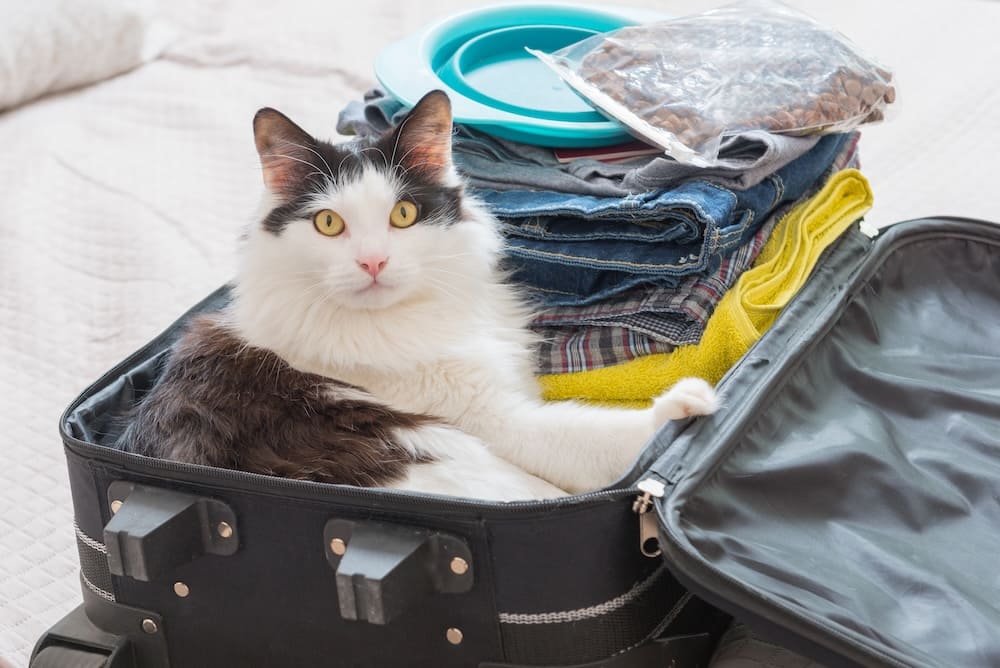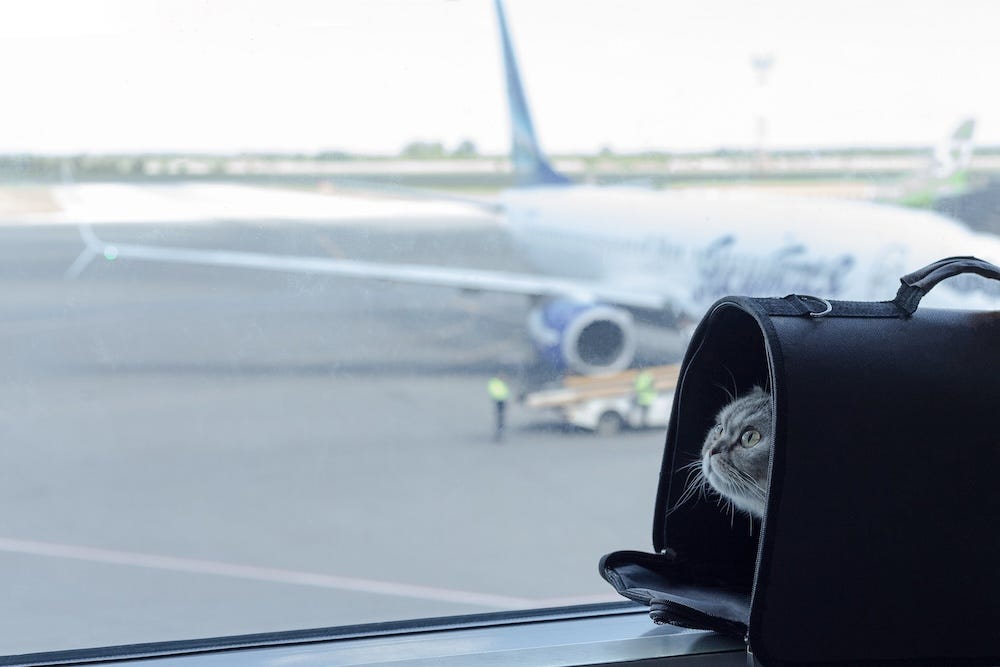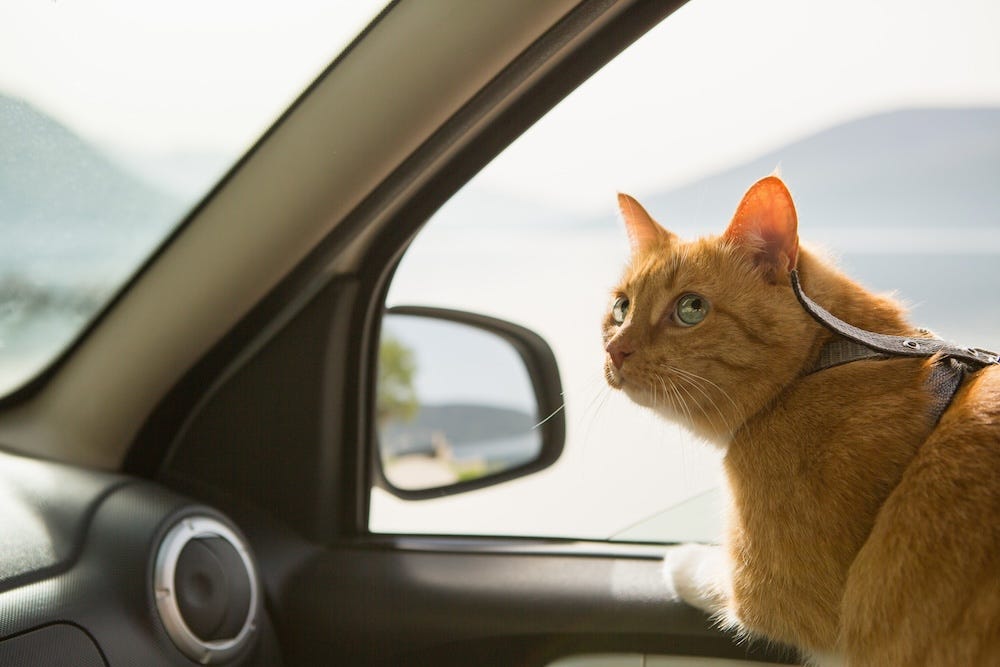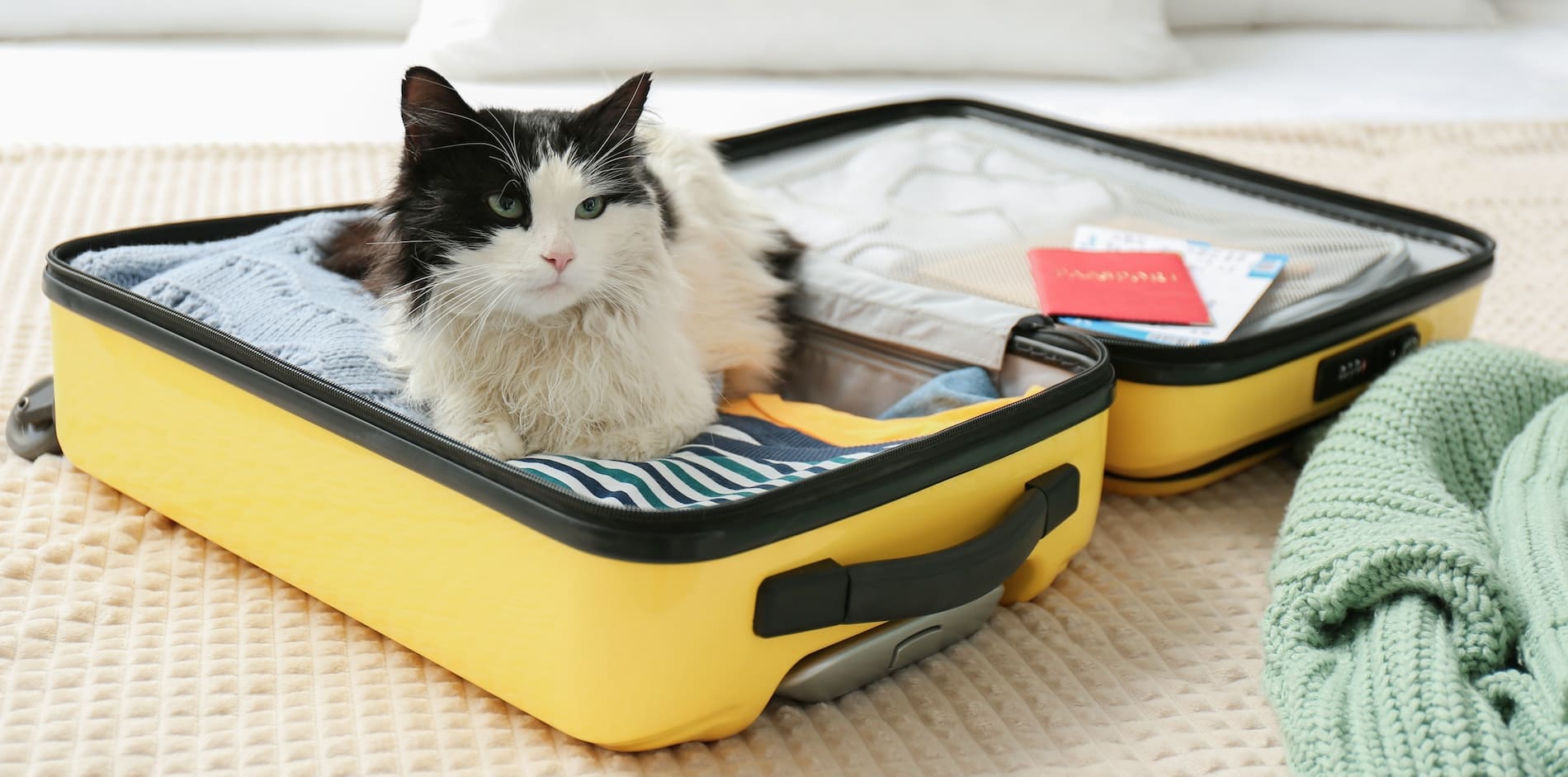Traveling with your feline companion can be both exciting and daunting. Whether you're planning a road trip or flying to a new destination, ensuring your cat's comfort and safety is paramount. This comprehensive guide will walk you through essential considerations, practical strategies, and options for leaving your cat behind if necessary. Let's dive in.
Questions to ask yourself before traveling with a cat

If you’re anything like us, you love your cat like a family member. However, think twice before bringing your feline family member on vacation. Dr. Laria Herod, veterinarian and cat parent, says, "Most cats hate traveling." Here are important travel facts that you must know before transporting your #1 baggage.
Can your cat handle the stress of travel?
Traveling can be stressful for cats, particularly those already prone to anxiety or nervousness. Consider your cat's temperament and past reactions to travel-related situations.
Signs of stress in cats include:
- Excessive vocalization
- Hiding
- Panting
- Refusal to eat
- Litter box issues
Excessive stress in cats might lead to aggressiveness, accidents outside the litter box, vomiting, destructive behavior, and even health issues in older cats. Make sure both you and your cat are prepared for it.
Is your cat up-to-date on vaccinations?
Vaccinations are vital for protecting your cat against infectious diseases, especially if you plan to spend more time outdoors. In addition, certain hotels or transport companies may require you to be up-to-date on required vaccines.
The recommended vaccines for cats are:
- Feline panleukopenia virus
- Feline viral rhinotracheitis, also known as herpes virus type 1 (FHV-1)
- Feline caliciviruses
- Rabies virus
- Feline leukemia virus (FeLV)
Does your cat have any health issues?
Cats with pre-existing health conditions may require special care and attention during travel. Consult with your veterinarian to assess your cat's health status and discuss any specific needs or accommodations they may require while on the road.
Sometimes, it might just be better for your cat to stay home.
Is your cat elderly or too frail for travel?
Age and health status are critical factors to consider when determining whether travel is suitable for your cat. Elderly cats or those with mobility issues may struggle with the physical demands of travel and may be better off staying in a familiar environment with proper care and supervision.
Does your cat exhibit any litter box issues?
Peeing outside the litter box, excessive urinating... Litter box problems can indicate underlying health issues or stress in cats; traveling will only add to that.
Address any existing litter box issues before traveling to minimize the risk of accidents during the journey. Ensure your cat has access to a clean, familiar litter box throughout the trip.
Are you aware of the pet travel regulations and requirements of your destination?
Different destinations may have specific regulations and requirements for traveling with pets, including health certificates, microchipping, and quarantine protocols. Research the pet travel regulations of your destination well in advance to avoid any issues during your trip.
Is it cruel to travel with a cat?
The answer to this question is truly cat-dependent. There are some cats that love to be with their people above all else and are fine with environmental changes, but this is not the case for most cats. Most cats are really resistant to changes in their environment, so it may not be worth putting your cat through the stress of traveling if you’re only going for a few days. Trust us—your cat may prefer to be at home instead of dealing with the noise and stress of traveling. (Think of it as their vacation away from you!)
If you are leaving for an extended period and your cat absolutely must come with you, make sure you are thoroughly prepared.
Should you use a cat sedative for travel?
Most cats get very stressed from travel. That’s why it’s important to chat with your veterinarian in advance about using a sedative (like high-dose gabapentin, butorphanol, or acepromazine) to relieve their anxiety. If your cat gets nauseated from motion sickness, your veterinarian can prescribe medications like Cerenia. When in doubt, ask your veterinarian how to start a “drug trial” at home several days before you go. This way, you know how your cat will respond to the medications (and if you need more or less!). In general, the medications typically need to be given 1-2 hours before your departure.
There are also over-the-counter cat sedatives for travel like feline pheromone sprays or calming cat supplements.
How to travel with a cat
Be prepared
Preparation is key to a successful journey with your cat. Consider the following:
- Schedule an appointment with your vet. If you travel out of state or out of the country, you’ll need a current health certificate (dated within 10 days of travel) to verify that your cat is healthy and up-to-date on vaccines, so make sure to do this in advance and with careful planning. You'll also need to verify that your cat doesn’t have any external or internal parasites (such as fleas, ticks, or gastrointestinal worms).
- Figure out your route. If you’re driving, plot out emergency veterinarians along the way and find pet-friendly hotels.
- Find the right cat carrier. Choose a carrier that's secure, well-ventilated, and comfortable for your cat. You should also acclimate your cat to the carrier weeks before the trip.
- Get your cat essentials. Make sure to be stocked up on extra cat food, cat treats, water bowls, and cat litter before hitting the road. Since your cat will now be exposed to many new places, getting the right flea and tick medication is also important. Plan for some cardboard cat scratchers as well. Light and easy to transport, this type of cat scratch pad will ensure you provide means for your cat to express emotions.
- Train your cat for the outdoors. Gradually introduce your cat to the outdoors using a harness and leash to ensure safety, especially if planning a road trip.
Remember to keep your veterinarian’s, the local emergency veterinary clinic’s, and the ASPCA Animal Poison Control Center’s phone numbers (888-426-4435) programmed in your cell phone in case of emergency.
On the road
Now that your preparations are done, you might wonder what to expect while you're on the road. We've assembled some tips and strategies to help you and your cat throughout the journey, so you'll arrive at your destination safe (and sane).
Flying with a cat

Flying can be a very stressful experience for cats, and you should avoid it if possible. Only travel by plane with cats if you are moving somewhere new. Vets like Dr. Justine Lee recommend that you:
- Book a direct flight to minimize stress. Layovers mean longer travel time, leading to more complex management of the litter box situation, for example.
- Fly with your cat in a carrier at your feet or in the seat next to you (depending on weight limitations). Shipping a cat in cargo would be much too stressful, as the extra loud noises, vibrations, feelings of nausea, and odors are overwhelming. Make sure not to open the carrier while on the flight. Not only will this help prevent any escapes, but it’ll appease the cat-allergic people near you.
- Check cat carrier regulations with airlines. Certain airlines have regulations on the types and sizes of soft-sided cat carriers they allow, so it's best to check a few weeks in advance to ensure you aren't scrambling at the last minute.
Once you’ve safely arrived at your new location, give your cat water and ample time to settle down before offering food.
Traveling by car with a cat

Once you hit the road, prioritize your cat's needs:
- Don't feed your cat before departure. Minimize vomiting or motion sickness.
- Keep your cat secured in a cat carrier. Not only may it be illegal for you to travel with your cat on your lap, but it can be distracting to you, putting everyone’s lives in danger. (And you only have 1 life, compared to the 9 of your cat!) Additionally, if your cat wanders near your brake pad, you’ll be unable to brake safely, resulting in a serious accident.
- Cat-friendly hotels: Choose pet-friendly accommodations that offer a safe and comfortable environment for your cat.
- On-the-go litter box solutions: Ensure your cat has access to a clean litter box and plan for frequent stops to allow them to relieve themselves.
- Limit travel time. Minimize stress by limiting daily travel time and incorporating breaks for your cat to stretch their legs. Take them outdoors on a leash if necessary.
- Avoid toxic plants. Watch out for toxic plants if you plan to be outdoors with your cat.
If you take a break from driving and leave your cat in the car, secure your cat carefully, leave the A/C running, or find a safe spot to leave your cat. Cars can heat up rapidly, resulting in heat stroke.
Leaving your cat home when traveling
When in doubt, don’t travel with your cat. If your cat is already dealing with anxiety, is elderly, or has a lot of health issues, it might just be safer to leave your cat comfortably home. Considering all the stress of travel for both you and your cat, a pet sitter will definitely make you both happier.
Leaving your cat home

When it's fine:
- Your cat is independent and comfortable being alone: Cats who are self-sufficient and happy being alone will do much better with periodic check-ins rather than constant supervision.
- You have a trustworthy and reliable person to check on your cat: Whether it's friends, family, or a professional cat-sitter, get the help of someone responsible who can visit your home regularly and attend to your cat's needs. Bonus points if they have experience with pets!
When it's not a good idea:
- You don't have anyone to check in: Even with automated pet care products like Litter-Robot or Feeder-Robot, leaving your cat alone without regular supervision can be risky if an emergency arises. (And unfair to your cat!)
- Your cat has special medical needs: Cats with medical conditions requiring close monitoring or medication administration are not suitable for unsupervised stays.
Tips:
- Cat-proof your home: Remove any hazards or potential dangers from your home environment to ensure your cat's safety in your absence.
- Prepare the essentials: Stock up on food, water, and litter before leaving, and consider investing in automated feeders and litter boxes for added convenience. Read our article about how much litter you need to learn more. You may also want to consider an automatic cat feeder.
- Consider an automatic litter box. Trust us, this will seal the deal in finding a friend to watch over your cat. Plus, with a self-cleaning litter box like Litter-Robot, you can get real-time usage information and notifications on the litter levels. Perfect when you're away from home!
- Determine visitation schedules: Ensure your cat receives adequate care and attention during your absence.
Leaving your cat at a friend's house

When it's fine:
- You have someone reliable: This might sound obvious—but as independent as cats are, they are creatures of habits, so their meals must be delivered on time. Plus, they need security and routine while you are away, especially if they are not in a familiar home.
- Your cat is friendly: If your cat is sociable and comfortable around other people, staying with a friend can provide a familiar and nurturing environment.
- Your friend doesn't have other pets, or they get along: A pet-free environment or one where your cat gets along well with existing pets can reduce stress and potential conflicts.
When it's not a good idea:
- Your cat is territorial: Cats can be territorial creatures, and staying in an unfamiliar environment may trigger stress or territorial behavior.
- There are other pets in the home: Introducing your cat to unfamiliar animals can lead to anxiety, conflicts, or even injuries, so it's best not to do it when you are also not around to provide a sense of security for your cat.
- Your cat already has issues at home: Existing behavioral or health issues may require specialized care and monitoring, which may be challenging for a friend to manage.
Tips:
- Choose a trusted pet sitter: Select a friend or family member who is responsible, reliable, and comfortable caring for cats.
- Prepare enough supplies: Food, medication, litter... ensure your friend has access to an ample supply to last them while you are gone.
- Provide a comprehensive guide: Prepare detailed instructions regarding your cat's routine, preferences, and any specific care instructions to ensure a smooth transition.
Leaving your cat at a pet hotel

When it's fine:
- Your cat is social: Pet hotels provide opportunities for socialization with other animals and human caregivers, which can benefit sociable cats.
- No one is available to check on your cat regularly: If you can't arrange for regular check-ins from friends or family, a pet hotel with 24/7 supervision can provide peace of mind.
When it's not a good idea:
- Your cat doesn't like to be crated or in a cage: Pet hotels typically keep cats in smaller enclosures. Though they might let them out occasionally, cats uncomfortable with confinement may experience stress or anxiety in a pet hotel environment.
- You can't afford the higher costs: On average, pet hotels cost between $15 and $45 per night, meaning they can get really expensive in the long term.
Tips:
- Prepare enough supplies: Pack your cat's favorite toys, bedding, and any necessary medications to ensure their comfort during their stay. Some pet hotels will charge you extra if you don't supply your own pet supplies.
- Crate-train your cat: Familiarize your cat with their carrier or crate before their stay to reduce anxiety and make the transition smoother.
Source: Road Trips and Car Travel With Your Cat




